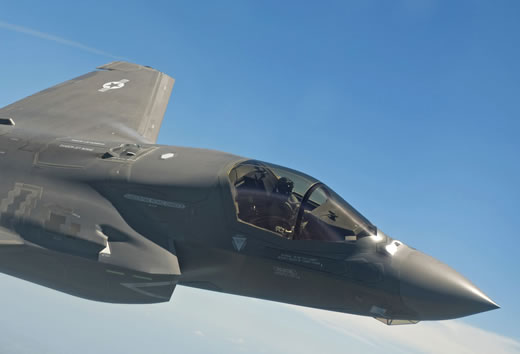
The United States may allow India to purchase its fifth generation F-35 Lightning II stealth fighter. According to Pentagon acquisitions Chief Ashton Carter, “there is nothing on our side, no principle which bars […] Indian participation in the Joint Strike Fighter. The decision to pursue the F-35 is India’s alone”. Offering the F-35 to India is not new – in 2007 Lockheed Martin briefed Indian officials on the F-35, but eventually the move was blocked by Washington.


Indeed, India has asked for the F-35. Lockheed Martin vice president Orville Prins confirmed his company already received a request for information from the Indian Navy, concerning the naval variants of the F-35 aircraft (F-35B STOVL and F-35C carrier conventional take off variants), both capable of operating from current and future Indian aircraft carriers. “We are going to offer our aircraft to them.” Prins confirmed. The aircraft are required to operate off two indigenously built aircraft carriers currently being constructed in India and due to enter service toward the end of this decade. The Indian Navy currently operates 11 Sea Harriers and has bought a squadron of MiG-29Ks to operate from the ex Russian Navy carrier due for delivery to India by 2012.
The possible release of JSF technology to India implies a substantial shift in U.S. policy toward India, which could be related to Washington shift to toward New Delhi, becoming a closer strategic ally that is equally concerned over the military growth of China. Sofar such a move was restrained by an effort to maintain U.S.-Pakistani relations at equal terms with U.S.-Indian relations. The new shift in Washington may indicate that the Pentagon is concerned about the status of the F-35, the program’s delays and the integrity of the JSF alliance, especially vis-a-vis the rapid progress of competitive programs in China and Russia – the latter, being a joint program with India. If the U.S. would wait for the PAK-FA program to mature, the U.S. could lose an opportunity to tap the Indian market for its 5th generation fighters. India is said to consider buying 250 T-50 5th generation fighters to be jointly developed with Sukhoi in Russia.
Another indicator of the policy shift is the rumor over a possible participation of a U.S. Air Force Lockheed Martin F-22A Raptor stealth fighter at Aero-India. It is yet unclear if the aircraft will land at Bangalore or fly in for short flight display. Until now the participation of Raptors in international shows was limited to the U.K., and Japan.
Carter also referred to India’s Medium Multi-Role Combat Aircraft (MMRCA) competition, where two U.S. fighters – Lockheed Martin F-16IN Super Viper and Boeing F/A-18E/F Super Hornet are competing against European and Russian rivals Eurofighter Typhoon, Dassault Rafale, Saab JAS-39 Gripen and the Mikoyan MiG-35 for an order of 126 aircraft. According to Carter, the U.S.-built fighters are the most technologically advanced aircraft in the competition.
One of the key factors stressed by the Americans is the operational AESA radars integrated in their aircraft. While the Russian and European fighters are offered with AESA radars that have not been integrated yet on the aircraft, both F-16 and A/F-18E/F are operationally flying with second generation AESA radars. Highlighting affordability, Carter stressed the importance of lifecycle costs, attributed to 70 percent of a platform’s life cycle cost. The U.S. officials argue that both the F-16 and F/A-18 offer the lower lifecycle costs than the competition.
New Delhi was never critical over the level of technology represented with the U.S. fighters, but was reluctant to be lured into deals that could not be supported by technology transfer. In this field, the Americans are way behind, bound by complex regulation. The European competitors, primarily Sweden were eager to offer everything they could to pave the way for their fighters to win the Indian hearts and minds. In contrast, the U.S., limited by complex technology transfer regulation could not offer technology transfer and, when it comes to the moment of truth, may not be able to offer everything the Indians want to get.
















